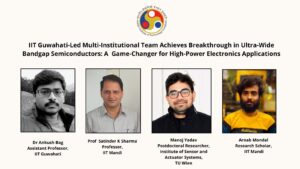GUWAHATI: Researchers from the Indian Institute of Technology (IIT), Guwahati have unveiled a cost-effective method for growing a revolutionary semiconductor.
The team led by Dr Ankush Bag, Assistant Professor in the Department of Electronics and Electrical Engineering and the Centre for Nanotechnology, in collaboration with IIT Mandi and the Institute of Sensor and Actuator Systems at Technical University Wien, has successfully devised the technology for growing ultrawide bandgap semiconducting material, namely gallium oxide.
This achievement is made possible through a customised low-pressure chemical vapour deposition (LPCVD) system.
Dr Bag said, “Power semiconductor devices are the heart of every power electronic system, functioning as efficient switches. For emerging high-power applications, there is a demand for compound semiconductor materials with an ultra-wide bandgap.”
Power electronic systems are pivotal in managing and controlling the flow of electricity, converting energy from both renewable and non-renewable sources for end-user applications.

While previous efforts focused on materials such as Gallium Nitride (GaN) and Silicon Carbide (SiC), limitations, especially in terms of cost, persisted for high-power applications.
“The main challenge was to create thin and smooth films from the material,” added Dr Bag.
After numerous trials and extensive studies, the team optimised the gallium oxide semiconductor, incorporating tin to enhance and modulate its conductivity.
The result is a superior quality ultra-wide bandgap compound semiconductor with applications spanning electric vehicles, high voltage transmission, traction systems, and industrial automation.
The findings of this groundbreaking research have been published in multiple research papers in prestigious journals, including the Journal of IEEE Transactions on Electron Devices and Thin Solid Films.
Co-authors include Dr Satinder K. Sharma and Arnab Mondal from the School of Computing and Electrical Engineering, IIT Mandi; Manoj K Yadav from the Institute of Sensor and Actuator Systems, TU Wien, Vienna, Austria, and Dr Bag.
This pioneering research has received funding from the Science and Engineering Research Board (SERB), Department of Science and Technology, marking a significant leap forward in the field of high-power electronics.














